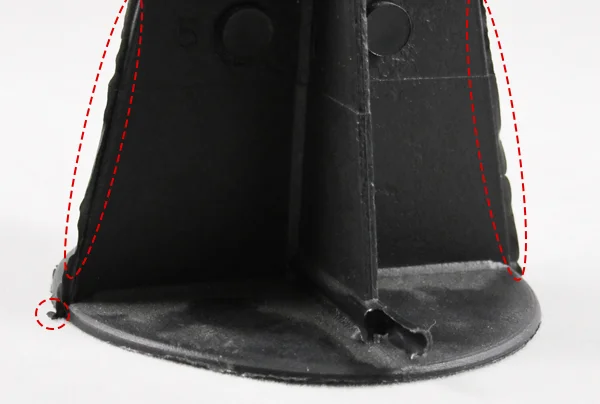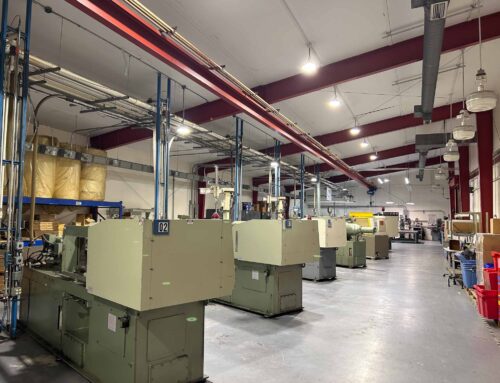Injection Molding Defect: Flash
 Injection molding is a manufacturing process for producing plastic parts with high precision and efficiency. However, like any complex manufacturing process, defects can be common and costly when not done carefully by experts. Attention to detail is critical to reduce defects and selecting the right manufacturer who knows how and cares to reduce the possibilities of defects is imperative to your bottom line. One common injection molding defect found in plastic molding is the occurrence of flash. In this article, we’ll explore what flash is, what causes it, and how it can be avoided to ensure high-quality plastic parts.
Injection molding is a manufacturing process for producing plastic parts with high precision and efficiency. However, like any complex manufacturing process, defects can be common and costly when not done carefully by experts. Attention to detail is critical to reduce defects and selecting the right manufacturer who knows how and cares to reduce the possibilities of defects is imperative to your bottom line. One common injection molding defect found in plastic molding is the occurrence of flash. In this article, we’ll explore what flash is, what causes it, and how it can be avoided to ensure high-quality plastic parts.
What is flash in injection molding?
Flash, also known as burr or excess material, refers to the thin layer of plastic that extends beyond the intended part geometry during the injection molding process. It typically appears as thin, unwanted plastic protrusions along the parting line or mold cavity edges. Injection molding flash usually occurs when molten plastic escapes the mold cavity, usually at the parting line, between inserts, or at ejector pin locations. Once the plastic cools and solidifies, it forms unwanted excess plastic on the part, that can negatively impact the form, function, and appearance of the plastic part. The flash defect can also increase production time and costs, as it usually requires manual trimming or the molded part is outright rejected.
What causes flash in injection molding?
Several factors can contribute to the formation of flash in plastic injection molding. One primary cause is inadequate clamping force, which occurs when the mold halves do not close tightly enough to prevent plastic from escaping between them. Excessive injection pressure or injection speed can also lead to flash by forcing molten plastic into gaps in the mold. Also, improper mold cavity venting can trap air or gas, causing the plastic to escape through tiny openings and create flash. Furthermore, a worn or damaged mold, such as an eroded or damaged parting surface, vent channels, or ejector pin holes, can exacerbate flash issues by providing a larger gap for the resin to flow through. Therefore, set up of the injection molding machine and an extensive QC / QA process are imperative to catch the first sign of injection molding flash.
How to avoid flash in injection molding.
Preventing flash requires careful attention to detail and adherence to best practices throughout the injection molding process. Having an optimized mold design is one way to help minimize the likelihood of flash formation. This includes ensuring proper alignment and fit between mold components, incorporating generous draft angles and radii, and providing adequate venting to allow trapped air and gases to escape. Regular tooling (maintaining and inspecting mold components, can help identify and address any wear or damage that could contribute to flash.
 Controlling the injection molding process parameters is another key aspect to help prevent flash in injection molding. By optimizing injection pressure, speed, and temperature settings, manufacturers can achieve better control over the flow of molten plastic and reduce the risk of flash formation. Using a higher clamping force can also help ensure that the mold halves remain tightly closed during injection, minimizing the potential for plastic outflow and flash.
Controlling the injection molding process parameters is another key aspect to help prevent flash in injection molding. By optimizing injection pressure, speed, and temperature settings, manufacturers can achieve better control over the flow of molten plastic and reduce the risk of flash formation. Using a higher clamping force can also help ensure that the mold halves remain tightly closed during injection, minimizing the potential for plastic outflow and flash.
Furthermore, employing advanced molding techniques such as gas-assisted injection molding or utilizing mold flow analysis software can help predict and mitigate potential flash issues before production begins. By simulating the injection molding process and identifying areas of concern, manufacturers, like Integrated Molding Solutions, can make informed decisions to optimize mold design and process parameters, ultimately minimizing the risk of flash and producing high-quality plastic parts.
In conclusion, flash is a common defect that can occur during injection molding, but it can be effectively prevented by precision injection molders, with proper mold design, maintenance, and process optimization. By understanding the causes of flash and implementing strategies to mitigate its occurrence, plastic manufacturers can ensure the production of high-quality plastic parts that meet the stringent requirements of their applications.






